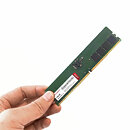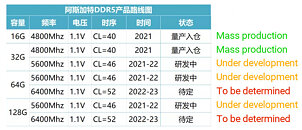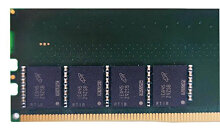Raevenlord
News Editor
- Joined
- Aug 12, 2016
- Messages
- 3,755 (1.15/day)
- Location
- Portugal
| System Name | The Ryzening |
|---|---|
| Processor | AMD Ryzen 9 5900X |
| Motherboard | MSI X570 MAG TOMAHAWK |
| Cooling | Lian Li Galahad 360mm AIO |
| Memory | 32 GB G.Skill Trident Z F4-3733 (4x 8 GB) |
| Video Card(s) | Gigabyte RTX 3070 Ti |
| Storage | Boot: Transcend MTE220S 2TB, Kintson A2000 1TB, Seagate Firewolf Pro 14 TB |
| Display(s) | Acer Nitro VG270UP (1440p 144 Hz IPS) |
| Case | Lian Li O11DX Dynamic White |
| Audio Device(s) | iFi Audio Zen DAC |
| Power Supply | Seasonic Focus+ 750 W |
| Mouse | Cooler Master Masterkeys Lite L |
| Keyboard | Cooler Master Masterkeys Lite L |
| Software | Windows 10 x64 |
Chinese company Jiahe Jinwei owns a sub-brand of gaming-oriented products named after Norse mythology - Asgard. The company has now announced that the trial production for high-speed DDR5 modules using Micron's semiconductors has completed without issue, meaning that their roadmap is going through without a hitch. Of course, as with the introduction of any new DDR memory standard, operating frequencies are still in their nascent stage; Asgard currently is only offering 4,800 MHz DDR5 sticks, which the most premium DDR4 sticks can already surpass.
It's only a matter of time before DDR5 speeds accelerate however, and Asgard is already planning to launch 5600 MHz DDR5 kits as early as 2022. These should be available in 32 GB and 128 GB capacities with a CAS latency of 46 cycles. The next step in performance increase would look towards 6,400 MHz kits, but these should only be expected towards the end of 2022 and beginning of 2023, should the development continue to move along smoothly. All of the DDR5 memory speeds should still make do with a relatively puny 1.1 V.



View at TechPowerUp Main Site
It's only a matter of time before DDR5 speeds accelerate however, and Asgard is already planning to launch 5600 MHz DDR5 kits as early as 2022. These should be available in 32 GB and 128 GB capacities with a CAS latency of 46 cycles. The next step in performance increase would look towards 6,400 MHz kits, but these should only be expected towards the end of 2022 and beginning of 2023, should the development continue to move along smoothly. All of the DDR5 memory speeds should still make do with a relatively puny 1.1 V.



View at TechPowerUp Main Site









